South West contributor Wayne Thomas relives the joys of his first summer LRF fishing and discovers it is a great way to grab a few moments hassle free fishing whilst on holiday.
I have been fishing for over forty years now and tend to view anything new with a mixture of interest and healthy scepticism. When a new approach to fishing called LRF (Light rock fishing) came to my attention I viewed it as the latest gimmick from foreign shores. A trip to my local reservoir with a bunch of lure fishing enthusiasts opened my eyes a little and I began to take more interest. Perhaps my specimen focused fishing was stopping me getting maximum fun from the sport I love.
I am an all-round angler and delight in casting a fly for wild trout that average four to the pound. I have enjoyed many a day catching silver flanked roach on light float tackle and consider myself a passionate though often frustrated mullet fisher so I am no stranger to the joys of light tackle.
I have always enjoyed employing lures to catch fish and last season I spent many hours targeting bass along the North Devon coast. Despite frequently challenging conditions I landed numerous bass up to 9lb and became convinced that lure fishing could be an equal to bait fishing when targeting specimen bass.
[caption id="attachment_3369" align="aligncenter" width="600"]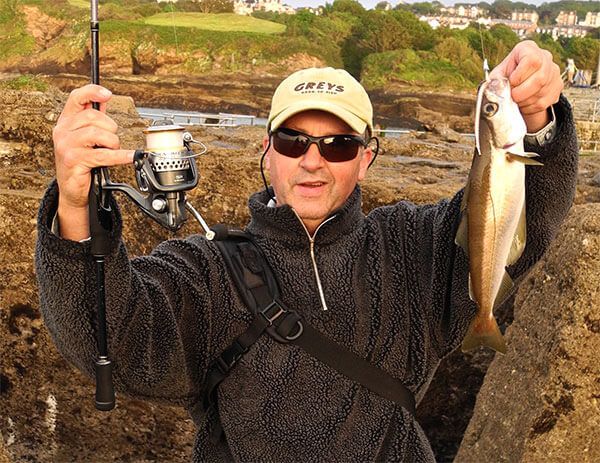 A hard fighting pollack for the author[/caption]
A hard fighting pollack for the author[/caption]
One big bonus in lure fishing is that it dictates the use of light tackle to present the lures to the fish thus promoting greater fun when hooking and playing fish.
This increased use of lures and in particular soft lures aroused increased interest in LRF fishing and its potential to bring more fun into fishing. Some of my friends have told me they see no point in LRF fishing, that they view as targeting tiddler’s that no right minded angler would wish to catch. Through the years I have spent many hours reeling in dogfish using a beachcaster and tackle strong enough to subdue a shark. Surely catching small fish on ultra light tackle is more of a challenge than this traditional approach to sea angling.
So with a fresh outlook let’s see what this LRF brings to the sport of sea angling. First of all there is the thrill and challenge of catching a wide variety of species. There is also the excitement of hooking small to medium sized fish on tackle that actually allows the angler to feel the pulse and pull of a fish on the line. The approach allows the angler to be highly mobile and to explore areas not previously fished. The cost of the gear is also well within anyone’s pocket; ideal for young anglers and families.
[caption id="attachment_3374" align="aligncenter" width="600"]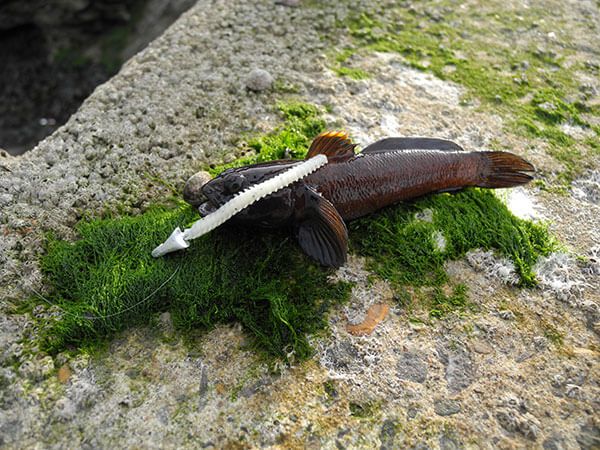 Rock Goby, a common LRF caught species[/caption]
Rock Goby, a common LRF caught species[/caption]
My first proper trip with the LRF gear was to a rock mark that I thought had potential for this form of fishing giving access to relatively deep water and a clear bottom adjacent to rocky features. It was a warm calm spring evening and it was a delight to be at the waters edge rod in hand.
The TRONIXPRO Rockfish L is a delightful little wand of a rod that exudes quality far beyond its moderate price tag; retailing at a shade over £30. The rod is designed to cast small lures of 3g to 12 g and has a fast action and a very sensitive tip that is designed to indicate the most delicate of takes.
I tied on a 2.5g jig head to 4lb fluorocarbon and threaded on a large Marukyu Isome ragworm. This was flicked out and allowed to sink close to the seabed. I was delighted when the light rod arched over as a fish that turned out to be a small Pollock dived for freedom. Every flick of the tail was felt through the light rod as a Pollock of about 8oz gave a surprisingly good account of itself.
[caption id="attachment_3373" align="aligncenter" width="600"]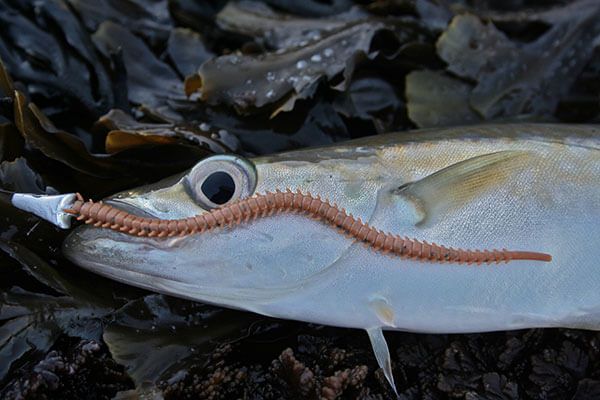 Small pollack succumbs to the LRF approach[/caption]
Small pollack succumbs to the LRF approach[/caption]
A couple of casts later the action was repeated this time with a slightly bigger Pollock that was nudging the pound mark. This fish gave a great scrap as it dived for the bottom taking a little line against the lightly set clutch. One more Pollock succumbed before the sun began to set in the western horizon and it was time to make for home.
My appetite was whetted and a few weeks later I was booked on a boat trip out off Weymouth. I decided to pack the LRF kit and explore the harbour area on the evening before my boat trip. This is where this style of fishing excels in that it gives an opportunity to grab a few moments fishing at the drop of a hat.
I wander along the harbour casting here and there with no success. Then I discovered another angler employing LRF tactics and eager to learn, I stopped for a chat. Angling is great at allowing easy communication between complete strangers. Within minutes we were sharing our passion for angling and discussing tactics. The angler I had met was a local angler called Robert Hallwill who often fished the venue catching a wide variety of species. Watching Robert flick his lure into gaps between boats and walkways I immediately followed suit searching the harbours many nooks and crannies. Fishing Marukyu Isome ragworm on a small jig head I started getting plenty of sharp rattles on the light rod tip. I also noted that the artificial ragworms could be presented on a small hook with a split shot to give the required casting weight a far cheaper option than jig heads.
[caption id="attachment_3370" align="aligncenter" width="600"]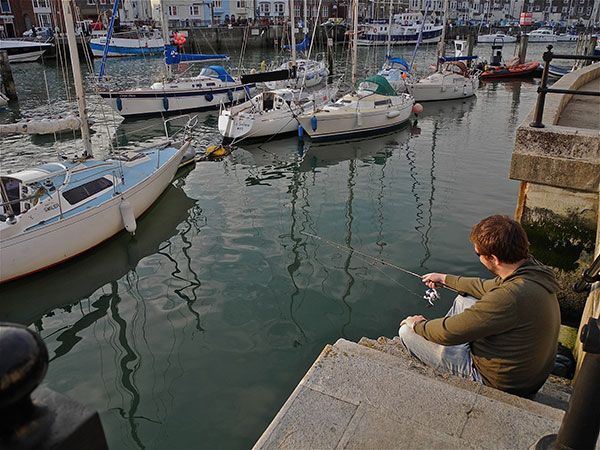 LRF Enthusiast Robert Haalwill[/caption]
LRF Enthusiast Robert Haalwill[/caption]
Despite a lack of fish on this trip I had learnt a lot and set out to employ my new skills at a venue closer to home. Ilfracombe Pier and harbour would I thought be an ideal venue and with this in mind I posted an invitation on our club Facebook page. Meet up at Ilfracombe Pier for an LRF session. Five club members met on an early summer evening as a warm easterly breeze blew onto the venue.
[caption id="attachment_3371" align="aligncenter" width="600"]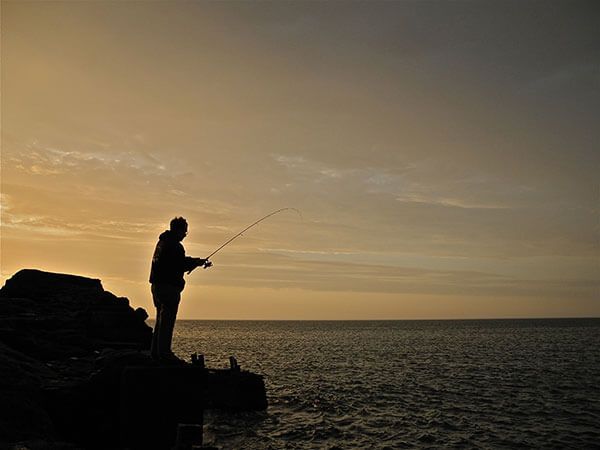 Matt Jeffery enjoys sport as the light fades.JPG[/caption]
Matt Jeffery enjoys sport as the light fades.JPG[/caption]
On arrival there was already a buzz of excitement as club member Troy Laing had just landed an anglerfish of close to a pound. The fish had been tempted using the ever-reliable Marukyu Isome ragworm. Chris Wilson had also scored already with a scorpion fish. I soon tackled up and began searching the waters close to the pier landings. Small Pollock soon succumbed giving a pleasing scrap on the light tackle. A delicate bite then resulted in a rock goby that brought a broad smile of satisfaction as the first of any new species do. Fellow club member Matt Jeffery told me he had enjoyed a great session the previous night landing several hard fighting mackerel on the light tackle. As the tide began to flood sport improved as the pollock switched on and gave a thrilling spell of fishing. My son James and his mate were also fishing close by and had shunned the LRF approach in favour of traditional float tactics. They too enjoyed good sport with the Pollock out fishing us by a considerable margin. They failed however to add any other species to the tally illustrating the power of LRF to catch a wide variety of species. My last cast of the evening resulted in a mackerel that again gave a great account on the light tackle.
[caption id="attachment_3372" align="aligncenter" width="600"]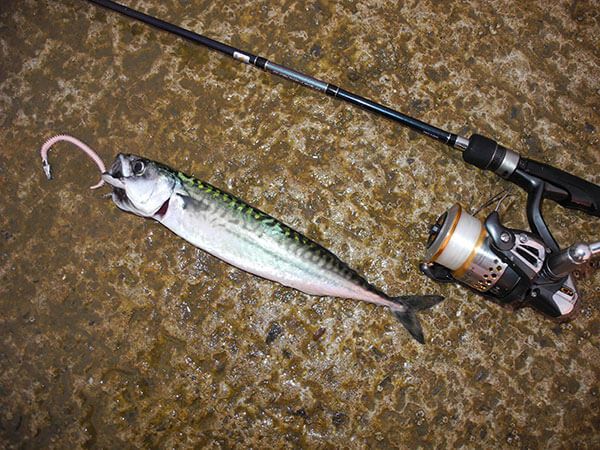 Mackerel give great sport on the light tackle[/caption]
Mackerel give great sport on the light tackle[/caption]
It was few weeks before I again packed the LRF gear on a short break to Dartmouth with my wife Pauline and nineteen year old son James. This was not a fishing session as such but a good way of keeping me still whilst watching the boats toing and froing. James cast out with a degree of scepticism; he had recently endured a week in Ireland casting lures for bass that failed to intercept our lures. (That’s another story). It was not long before I received a few rattles on the LRF kit and soon swung a small sand goby to hand. One up I taunted James who had also had one or two tentative plucks at his artificial ragworm.
Suddenly my rod tip surged over as something larger seized my offering. The light rod took on a pleasing battle curve and I enjoyed the thrill as whatever I had hooked attempted to put distance between itself and the harbour wall. A few minutes later I was pleased to lift a school bass of around two pounds from the water having scuttled down the out of bounds steps to secure my prize. After a quick photo the bass was slipped back. After another half an hour of fishing we both had several more bites with a small rock goby securing a three fish to nil victory against James. To be honest I would rather he caught the fish but I was not letting him know that!
[caption id="attachment_3377" align="aligncenter" width="600"]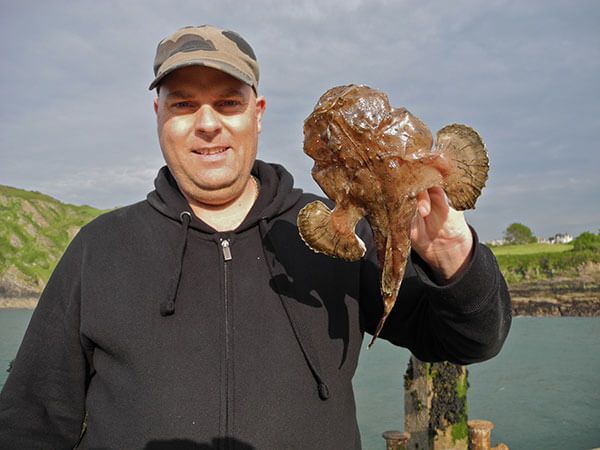 Troy Laing with an angler fish tempted on LRF gear[/caption]
Troy Laing with an angler fish tempted on LRF gear[/caption]
A couple of weeks later and we were on holiday at Noss Mayo in South Devon and once again the LRF kit had been loaded into the car on the off chance that a few moments could be found to have a dabble. This was not a fishing holiday!
Whilst exploring the area we came across a pontoon that gave access to the Yealm estuary and to my surprise, fishing from the pontoon was tolerated so long as access was kept free for boat users etc. I thought this would be the ideal place to try out the LRF gear and proceeded to cast around with the Marukyu Isome ragworm. To my surprise bites were not forthcoming and after twenty minutes all we had to show for our efforts was a small sea scorpion that mainstay of the LRF angler.
[caption id="attachment_3376" align="aligncenter" width="600"]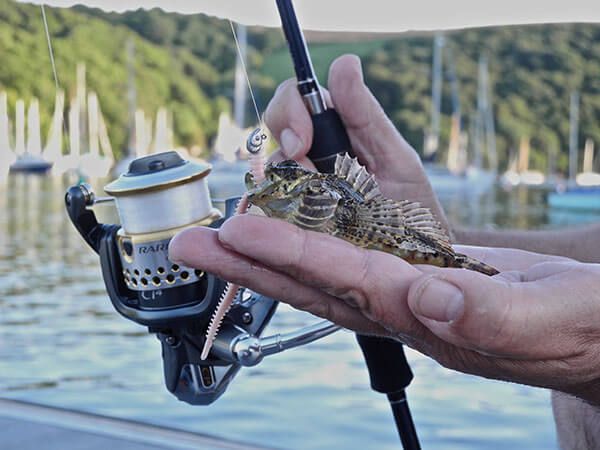 Scorpion Fish[/caption]
Scorpion Fish[/caption]
The next day we headed to the beach and once again the LRF gear came along. On a visit to Plymouth we had called into the “Art Of Fishing” shop where I had been tempted by a few lures including a packet of Flash J Split 3'' lures that are perfect imitations of small whitebait. The beach was packed with families enjoying the sun, bathers frolicked in warm waters as a light wave rolled onto the warm sand. Shortly after arrival I strolled to the waters edge for a look and spotted a few swirls in the clear water where a river flowed out into the bay.
A few minutes later I stood up to my knees in the clear waters flicking out one of the small Flash J lures. Fish on! First cast a small school bass of 8oz or so. The next half an hour is hectic sport with virtually a fish a cast the best pushing a pound, all great fun on the LRF gear and 4lb fluorocarbon.
[caption id="attachment_3375" align="aligncenter" width="600"]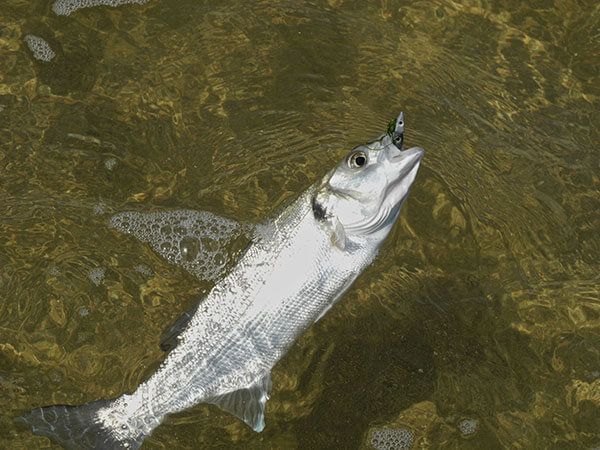 School bass give great sport from the sandy beach.[/caption]
School bass give great sport from the sandy beach.[/caption]
This is the great thing with LRF fishing its great for grabbing a few moments of fun fishing. Ideal for families and young anglers and fun for the seasoned angler prepared to get back to basics. In addition lessons are learnt whilst catching small fish that can be applied later whilst targeting those bigger specimens with heavier gear. There is always of course the possibility that you will hook a big fish on the LRF gear and with skill you should have every chance of landing the fish as any bass that swims in UK waters is tameable on LRF gear conditions and skill permitting.
I have been fishing for over forty years now and tend to view anything new with a mixture of interest and healthy scepticism. When a new approach to fishing called LRF (Light rock fishing) came to my attention I viewed it as the latest gimmick from foreign shores. A trip to my local reservoir with a bunch of lure fishing enthusiasts opened my eyes a little and I began to take more interest. Perhaps my specimen focused fishing was stopping me getting maximum fun from the sport I love.
I am an all-round angler and delight in casting a fly for wild trout that average four to the pound. I have enjoyed many a day catching silver flanked roach on light float tackle and consider myself a passionate though often frustrated mullet fisher so I am no stranger to the joys of light tackle.
I have always enjoyed employing lures to catch fish and last season I spent many hours targeting bass along the North Devon coast. Despite frequently challenging conditions I landed numerous bass up to 9lb and became convinced that lure fishing could be an equal to bait fishing when targeting specimen bass.
[caption id="attachment_3369" align="aligncenter" width="600"]
 A hard fighting pollack for the author[/caption]
A hard fighting pollack for the author[/caption]One big bonus in lure fishing is that it dictates the use of light tackle to present the lures to the fish thus promoting greater fun when hooking and playing fish.
This increased use of lures and in particular soft lures aroused increased interest in LRF fishing and its potential to bring more fun into fishing. Some of my friends have told me they see no point in LRF fishing, that they view as targeting tiddler’s that no right minded angler would wish to catch. Through the years I have spent many hours reeling in dogfish using a beachcaster and tackle strong enough to subdue a shark. Surely catching small fish on ultra light tackle is more of a challenge than this traditional approach to sea angling.
So with a fresh outlook let’s see what this LRF brings to the sport of sea angling. First of all there is the thrill and challenge of catching a wide variety of species. There is also the excitement of hooking small to medium sized fish on tackle that actually allows the angler to feel the pulse and pull of a fish on the line. The approach allows the angler to be highly mobile and to explore areas not previously fished. The cost of the gear is also well within anyone’s pocket; ideal for young anglers and families.
[caption id="attachment_3374" align="aligncenter" width="600"]
 Rock Goby, a common LRF caught species[/caption]
Rock Goby, a common LRF caught species[/caption]My first proper trip with the LRF gear was to a rock mark that I thought had potential for this form of fishing giving access to relatively deep water and a clear bottom adjacent to rocky features. It was a warm calm spring evening and it was a delight to be at the waters edge rod in hand.
The TRONIXPRO Rockfish L is a delightful little wand of a rod that exudes quality far beyond its moderate price tag; retailing at a shade over £30. The rod is designed to cast small lures of 3g to 12 g and has a fast action and a very sensitive tip that is designed to indicate the most delicate of takes.
I tied on a 2.5g jig head to 4lb fluorocarbon and threaded on a large Marukyu Isome ragworm. This was flicked out and allowed to sink close to the seabed. I was delighted when the light rod arched over as a fish that turned out to be a small Pollock dived for freedom. Every flick of the tail was felt through the light rod as a Pollock of about 8oz gave a surprisingly good account of itself.
[caption id="attachment_3373" align="aligncenter" width="600"]
 Small pollack succumbs to the LRF approach[/caption]
Small pollack succumbs to the LRF approach[/caption]A couple of casts later the action was repeated this time with a slightly bigger Pollock that was nudging the pound mark. This fish gave a great scrap as it dived for the bottom taking a little line against the lightly set clutch. One more Pollock succumbed before the sun began to set in the western horizon and it was time to make for home.
My appetite was whetted and a few weeks later I was booked on a boat trip out off Weymouth. I decided to pack the LRF kit and explore the harbour area on the evening before my boat trip. This is where this style of fishing excels in that it gives an opportunity to grab a few moments fishing at the drop of a hat.
I wander along the harbour casting here and there with no success. Then I discovered another angler employing LRF tactics and eager to learn, I stopped for a chat. Angling is great at allowing easy communication between complete strangers. Within minutes we were sharing our passion for angling and discussing tactics. The angler I had met was a local angler called Robert Hallwill who often fished the venue catching a wide variety of species. Watching Robert flick his lure into gaps between boats and walkways I immediately followed suit searching the harbours many nooks and crannies. Fishing Marukyu Isome ragworm on a small jig head I started getting plenty of sharp rattles on the light rod tip. I also noted that the artificial ragworms could be presented on a small hook with a split shot to give the required casting weight a far cheaper option than jig heads.
[caption id="attachment_3370" align="aligncenter" width="600"]
 LRF Enthusiast Robert Haalwill[/caption]
LRF Enthusiast Robert Haalwill[/caption]Despite a lack of fish on this trip I had learnt a lot and set out to employ my new skills at a venue closer to home. Ilfracombe Pier and harbour would I thought be an ideal venue and with this in mind I posted an invitation on our club Facebook page. Meet up at Ilfracombe Pier for an LRF session. Five club members met on an early summer evening as a warm easterly breeze blew onto the venue.
[caption id="attachment_3371" align="aligncenter" width="600"]
 Matt Jeffery enjoys sport as the light fades.JPG[/caption]
Matt Jeffery enjoys sport as the light fades.JPG[/caption]On arrival there was already a buzz of excitement as club member Troy Laing had just landed an anglerfish of close to a pound. The fish had been tempted using the ever-reliable Marukyu Isome ragworm. Chris Wilson had also scored already with a scorpion fish. I soon tackled up and began searching the waters close to the pier landings. Small Pollock soon succumbed giving a pleasing scrap on the light tackle. A delicate bite then resulted in a rock goby that brought a broad smile of satisfaction as the first of any new species do. Fellow club member Matt Jeffery told me he had enjoyed a great session the previous night landing several hard fighting mackerel on the light tackle. As the tide began to flood sport improved as the pollock switched on and gave a thrilling spell of fishing. My son James and his mate were also fishing close by and had shunned the LRF approach in favour of traditional float tactics. They too enjoyed good sport with the Pollock out fishing us by a considerable margin. They failed however to add any other species to the tally illustrating the power of LRF to catch a wide variety of species. My last cast of the evening resulted in a mackerel that again gave a great account on the light tackle.
[caption id="attachment_3372" align="aligncenter" width="600"]
 Mackerel give great sport on the light tackle[/caption]
Mackerel give great sport on the light tackle[/caption]It was few weeks before I again packed the LRF gear on a short break to Dartmouth with my wife Pauline and nineteen year old son James. This was not a fishing session as such but a good way of keeping me still whilst watching the boats toing and froing. James cast out with a degree of scepticism; he had recently endured a week in Ireland casting lures for bass that failed to intercept our lures. (That’s another story). It was not long before I received a few rattles on the LRF kit and soon swung a small sand goby to hand. One up I taunted James who had also had one or two tentative plucks at his artificial ragworm.
Suddenly my rod tip surged over as something larger seized my offering. The light rod took on a pleasing battle curve and I enjoyed the thrill as whatever I had hooked attempted to put distance between itself and the harbour wall. A few minutes later I was pleased to lift a school bass of around two pounds from the water having scuttled down the out of bounds steps to secure my prize. After a quick photo the bass was slipped back. After another half an hour of fishing we both had several more bites with a small rock goby securing a three fish to nil victory against James. To be honest I would rather he caught the fish but I was not letting him know that!
[caption id="attachment_3377" align="aligncenter" width="600"]
 Troy Laing with an angler fish tempted on LRF gear[/caption]
Troy Laing with an angler fish tempted on LRF gear[/caption]A couple of weeks later and we were on holiday at Noss Mayo in South Devon and once again the LRF kit had been loaded into the car on the off chance that a few moments could be found to have a dabble. This was not a fishing holiday!
Whilst exploring the area we came across a pontoon that gave access to the Yealm estuary and to my surprise, fishing from the pontoon was tolerated so long as access was kept free for boat users etc. I thought this would be the ideal place to try out the LRF gear and proceeded to cast around with the Marukyu Isome ragworm. To my surprise bites were not forthcoming and after twenty minutes all we had to show for our efforts was a small sea scorpion that mainstay of the LRF angler.
[caption id="attachment_3376" align="aligncenter" width="600"]
 Scorpion Fish[/caption]
Scorpion Fish[/caption]The next day we headed to the beach and once again the LRF gear came along. On a visit to Plymouth we had called into the “Art Of Fishing” shop where I had been tempted by a few lures including a packet of Flash J Split 3'' lures that are perfect imitations of small whitebait. The beach was packed with families enjoying the sun, bathers frolicked in warm waters as a light wave rolled onto the warm sand. Shortly after arrival I strolled to the waters edge for a look and spotted a few swirls in the clear water where a river flowed out into the bay.
A few minutes later I stood up to my knees in the clear waters flicking out one of the small Flash J lures. Fish on! First cast a small school bass of 8oz or so. The next half an hour is hectic sport with virtually a fish a cast the best pushing a pound, all great fun on the LRF gear and 4lb fluorocarbon.
[caption id="attachment_3375" align="aligncenter" width="600"]
 School bass give great sport from the sandy beach.[/caption]
School bass give great sport from the sandy beach.[/caption]This is the great thing with LRF fishing its great for grabbing a few moments of fun fishing. Ideal for families and young anglers and fun for the seasoned angler prepared to get back to basics. In addition lessons are learnt whilst catching small fish that can be applied later whilst targeting those bigger specimens with heavier gear. There is always of course the possibility that you will hook a big fish on the LRF gear and with skill you should have every chance of landing the fish as any bass that swims in UK waters is tameable on LRF gear conditions and skill permitting.

